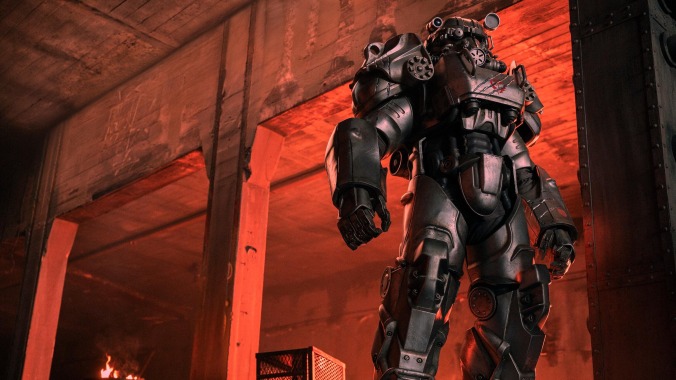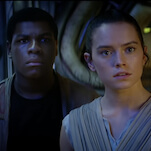Fallout Photo: JoJo Whilden/Prime Video
[Editor’s note: This is a recap of Fallout episode three. The recap of episode four publishes April 15.]
When you watch a lot of genre TV and movies, you tend to build up a stomach for fucked-up stuff. Eyes where eyes shouldn’t be, brains blowing out the back of skulls;, blood and viscera in abundance: These are the pigments with which deliciously nasty sci-fi and horror paints. Still, the giant lizard with human fingers for teeth, which is then induced to vomit up its entire stomach lining? That one got to us, just a teensy bit!
It’s to Fallout’s increasing credit that it can, in its third episode, do some real character work alongside its gleeful urge to gross out viewers. Take the early scene that sees Lucy chatting placidly with Wilzig’s severed head, so recently liberated from his neck at his own request. Ella Purnell has a serious knack for projecting Lucy’s cheerful acceptance of the horrors around her, curiously chatting with the head while hunting around for whatever MacGuffin is lurking under the skin. That optimism might find itself tested later on in the episode, but it’s vital to making her character both weirdly admirable and very funny. Walton Goggins was the bigger name going in to the series, and Aaron Moten does fine work as Maximus, but of Fallout’s three leads, Purnell is the revelation here: The show’s delicately balanced tone just wouldn’t work without her selling the way she’s smiling through the horror.
Speaking of Goggins: We spend quite a bit more time with his Ghoul here than we have previously, revealing that he’s ultimately driven far more by pragmatism than outright cruelty. (Note the way he immediately shifts gears once he realizes that Lucy’s struggles with the gigantic Gulper have ruined his supplies of whatever that yellow medication he inhales is. Bounties are nice, and there’s always time for a bit of casual meanness, but survival is clearly everything for him.) At the same time, prolonged exposure to the character raises some questions about depth, which are only mostly papered over by Goggins’ undeniable charisma. At this point, the Ghoul is operating almost like a parody of the most memorable villain from Jonathan Nolan’s previous show, Westworld, a comparison only highlighted by Fallout’s decision to demonstrate the character’s nuances through flashbacks showing him before the fall. In the present, Goggins is playing someone who borders on a cartoon—the stock badass, complete with accent—and we can only hope the show knows how to pull back from that brink as we get more time with the man Cooper Howard has become.
Splitting the difference, as usual, is Maximus, who maintains his status as the only one of Fallout’s three leads whose behavior we (happily) struggle to predict from moment to moment and scene to scene. Maximus, cut off from the other two, gets put through the ringer in this episode, first forced to sell a tooth to get his broken armor fixed, then getting the shit kicked out of him by some yokels hoping to steal it. After exploding one dude’s head (in a delightfully gnarly effects shot, Moten playing the moment for shock) to save his stuff, the young Squire gets even worse news: Not only is the Brotherhood sending him a new Squire to replace the “dead” Maximus, but the new recruit is Thaddeus, one of his previous tormentors back at camp.
The subsequent scenes, with Maximus finding himself taking sick pleasure in bullying his former oppressor, are what we mean when we say we find the character pleasantly unpredictable: We would have taken equal odds on Thaddeus ending the episode as a smear on the Wasteland rocks, instead of actually finding ways to bond with his “Knight,” the two ultimately reconciling (albeit, with the Squire still in the dark about his boss’ true identity). Along the way, Johnny Pemberton (whose “Hey It’s That Guy!” cred is already strong at this point, despite being relatively young) manages to give a weirdly sweet eulogy for the “dead” Maximus, expressing his wish that his victim could have lived long enough to find someone to victimize himself. These are the moments that make Fallout work: absurd on the face of it, but cut with a genuine vein of relatable emotion. It’s enough to make you root for these two survival-challenged bros, even if at least one of them is almost certainly doomed as soon as the truth about Knight Titus’ death comes out.
And then, meanwhile, down in Vault 33, things aren’t looking a whole lot less doomed. It’s an interesting decision, on the part of showrunners Geneva Robertson-Dworet and Graham Wagner, to pull us back to Lucy’s home so abruptly after it felt like we’d be leaving the Vault behind forever—especially in an episode that already feels like it’s mostly rooted in set-up and moving pieces around the board. The show’s first episode showed that most of the Vault Dwellers were too thin to be much more than comedy caricatures, something Zach Cherry and Rodrigo Luzzi, as “co-Overseers” Woody and Reg, re-demonstrate here (to comedic effect, but not much more). But there are interesting threads lurking underneath the plastic and metal sheen, mostly in the eyes of Leslie Uggams and Moisés Arias, the latter of whom (as Lucy’s brother Norm) seems ready to kick off a civil war to execute the raiders the Vault is currently keeping alive. Arias mostly hung out in the background of the premiere, but he makes a massive, chilling impression here, demonstrating that he’s going to be pretty vital to whatever story Fallout is ultimately trying to tell.
Fallout has not been shy about establishing, as its primary theme, an examination of the old adage “adapt or die.” Michael Emerson gave some very nice speeches about it last episode, and the Ghoul exists, at least in part, to demonstrate what that concept looks like at its terminal point. In the video games from which the series pulls, that message was played to tragic effect: The first Fallout ends with your Vault Dweller returning triumphantly to their home, only to be told they’ve changed too much, become too violent and hardened, to be brought back within its safe metal walls. Fallout the show seems interested in pushing that concept even further, suggesting that violent pragmatism is something akin to an infectious agent. Note the way the community members most receptive to Norm’s cold-blooded entreaties are the ones who suffered the most violence in the attacks—lending credence to the idea that, in this world, you’re either a killer or a fool.
Which brings us back around to Lucy, who’s neither—at least, not yet. If Fallout’s third episode is mostly about moving pieces around the board (and can, thus, be a bit boring in spots, giant lizard monster notwithstanding) then it’s mostly interesting for where it leaves Lucy: a forced student in a masterclass on pragmatism, delivered courtesy of the ultimate survivor. We’re excited to note that we have no idea where her education will go from here.
Stray observations
- Just as a reminder: I’m writing these recaps as I’m watching the series, so I have no idea where this will all wrap up. I’m excited to find out with all of you!
- Fallout Games Corner: The medicine the Ghoul is fixated on seems pretty likely to be Rad-Away, a blatantly magical drug from the Fallout universe that soaks radiation out of the human body. As a ghoul, The Ghoul would be immune to radiation—but prolonged exposure to the stuff can increase the likelihood of a ghoul devolving into a feral, zombie-esque creature, which would explain why Cooper is so desperate to keep himself dosed up. (Note that he was also receiving the drug while he was buried, per the IV that was running down into his grave in the premiere.) Meanwhile, the Gulper doesn’t have a direct analogue in the games, but it seems to fill the same niche as the carnivorous Geckos—albeit with a body-horror element that speaks to some of the F.E.V. mutants that pop up in the nastier zones of most of the games.
- Correction: As people in the comments of this review have pointed out, The Gulper is pulled from the Far Harbor DLC of Fallout 4. My terrible secret is thus exposed: Although I’ve probably spent 500 hours, all told, playing Fallout games throughout my life, I think 4 is pretty profoundly mediocre, and so have never played its DLCs. Apologies for the error!
- As I noted in a previous stray observations, the broken water chip is the MacGuffin from the first Fallout and the catalyst for that game’s Vault 13 opening its doors for the first time in centuries.
- The opening flashback to Cooper in Hollywood is a little on the nose with all its “new kind of Western” stuff, but at least it does confirm that he’s on the right side of history vis a vis lavender-flavored candy. Yuck!
- Goggins’ goofy little run right before the cut back to the present is extremely cute.
- Honestly surprised it took the show this long to use the Ink Spots’ “Maybe,” perhaps the most iconic Fallout soundtrack song.
- What do you do with a prop of Michael Emerson’s severed head when a show like this is over? We hope Emerson gets to keep it; what a conversation piece that would be.
- This episode establishes that Vaults 31, 32, and 33 are all connected to each other, which was one of the weirder things from the premiere. (In the games, each Vault exists in total isolation, but it makes sense if this interdependent structure is one of Vault-Tec’s various “innovations” in human behavior.)
- A nasty argument breaks out in the Vault about how to handle the captured raiders: Do they rehabilitate them by teaching them Shakespeare, Kant, or introductory calculus?



![HBO teases new Euphoria, Larry David, and much more in 2026 sizzle reel [Updated]](https://img.pastemagazine.com/wp-content/avuploads/2025/12/12100344/MixCollage-12-Dec-2025-09-56-AM-9137.jpg)





































